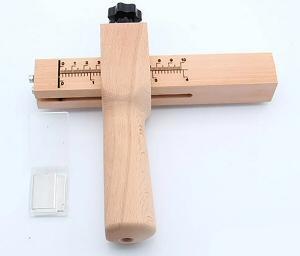-
Posts
5,928 -
Joined
Content Type
Profiles
Forums
Events
Blogs
Gallery
Everything posted by fredk
-
I agree , it looks like a leaky bottle of something, such as alcohol based after-shave. Treat that panel by washing it down with alcohol or lacquer cleaner and try re-dyeing just that panel very carefully. It'll probably end up a different shade though
-
Might I suggest something? If you want tubes, go to your local carpet shop. They'll have the card tube cores from carpets. A. they are very robust and b. are about 12 to 13 ft long, so you can cut them down to size. I used them for a while. The carpet shop was very happy to give me a load of tubes just to be rid of them
-
Currently I keep my stiff leathers rolled up in large plastic boxes designed for storing re-useable Christmas trees. The boxes are about 5 ft long and and about 1 foot x 1 foot. The boxes are stackable. For my thin lining leathers, they are folded up and stored in a large-ish plastic box (actually x 2 of them). The long boxes are stored in my apartment's crossway hall and the back hall.
-
Not papyrus but birch and alder wood 'post cards' - the Vindolanda Tablets, or Letters. Thousands of them
-
Look for books by Olaf Goubitz. Especially Stepping Through Time. Archaeological footwear from prehistoric times until 1800 ( https://www.abebooks.co.uk/9789089320025/Stepping-Time-Archaeological-Footwear-Prehistoric-9089320024/plp )and Op lage schoenen in de kou Also, From the Museum of London; Shoes and Pattens Medieval finds from excavations in London ( https://www.amazon.co.uk/Shoes-Pattens-Medieval-Excavations-London/dp/1843832380/ref=pd_lpo_3?pd_rd_i=1843832380&psc=1 ) I have the first and last books on my book shelf and they have what you seek I have this book in PDF form. Its about 388 pages in PDF. Hard copy of the full book costs about £300. Smaller 'section' books cost about £25 each Leather and Leatherworking in Anglo-Scandinavian and Medieval York It was partly that and that the items were in a garbage dump that the Romans tried to burn. The outside burnt and sealed off the interior
-
I find that Resolene is no longer a good sealant. I prefer to use a certain 'floor polish' which is actually a water thin acrylic varnish. In your area it might be called 'Mop & Glo'. Thin the M&G with water and dip the collars into it. Dip, drip dry to almost dry, do this about 3 or 4 times and the collars should be well sealed
-
Just quoting to get your attention; How many, what size and what colour of snap / popper do you need? If its only a couple or few, I may be able to sort out some from my stock, with rivet caps to match and send them to you. FOC
-
They've held up very well indeed. If you fit the rivet cap down tight there is no stress on the glued joint. Even if you try to get the rivet cap off you need to wreck the popper. btw, I used super-glue gel which fills gaps better On this shield guige strap the poppers are on the tan part. I hid the base with rivet heads. I did this on all the shields I made and nary a one ever came off even though those shields were used in 'battle'
-
I've just finished 8 of these Christmas tree hangers. I took the notion to make them this afternoon and set-to earlier this evening. All put together with double-sided tape and glue. They're about 3 & 3/4 inches long by 2 & 3/4 inches wide at heel to toe. Showing both sides. All are red on one side and green on the other. I'll give them to my ladies tomorrow afternoon
-
I've never found any of what you want. What I've done is to super-glue the cap part of a ready-rivet on to the popper back plate. The short stem of the rivet cap fits well into the hole on the popper base
-

What kind of Hammer for stichlines and gluing?
fredk replied to Silvyr's topic in Leatherwork Conversation
I have few hammers to choose from; a brass head, a tacking, a cobblers, a car-body plus a rubber & plastic head mallet, two different poly mallets. I use which ever come to hand when I reach into the tool box. Don't be paranoid about the smoothness of the hammer face. As long as there isn't a big chunk sticking out, slight dinges in a hammer or mallet face aren't going to transfer to your leather if you are just lightly tapping the stitching or glue joint. Its not a 6 inch nail you are trying to put through oak so you only need to go lightly -
On skiving the area for a belt buckle I find slicing at an angle works best. On doing edges I use it at a slight angle
-
When I started in this leather crafting lark I used the 'folded card' method for shaping the ends of belts. Later I bought one large 'English' belt tip punch. That one large size does all the smaller one too. I've also bought a set of belt templates in acrylic, like these uns, (below) they cost me under £5 for the set but are dearer now, With them you have the two most common ends https://www.ebay.co.uk/itm/265264220814?hash=item3dc2faca8e:g:~VIAAOSwq1VhFIl5
-
Bees wax - warm some bees wax and warm up your piece. Rub in a good coating of bees wax, use a hair dryer to help make the wax soak into the leather. When you have a very good coating all over, leave it to harden, then buff it until your arms fall off
-
verily, interesting. I must try this way on my next project
-
oh, gotch ya now,
-

Are all cheap strap cutters created equal?
fredk replied to BriarandThorne's topic in Getting Started
One cheap cutter I think should be avoided; it has the two bars which you pass the leather through as a single bar with just a saw cut for the opening. I think this would limit the thickness of leather you can pass through, whereas on mine there is a captive threaded bolt to adjust that gap -
Nice, but why dye it? Its good just as it is
-
I've had success with thin thread, on short sewing runs, by threading the needle, giving about 2 inches of free length, folding that back on to the main length then rubbing in bees wax and then rolling the needle and thread on the work bench, pressing it together to get one smooth length of coated thread. Takes longer to write this than actually doing it. btw; If I can I always pierce thread to lock it on a needle. afair I picked that method up from an Al Stohlman book
-
Bestest years I had was as a postie in UK. Only company to give you a bicycle as your 'company' vehicle. Clocked up thousands of miles delivering post / mail by bicycle.
-
Depending on your exact requirements; just glue in a piece of thick compressed card, card such as you get on the 'do not fold' certificate envelopes. I keep this card for just such as use. Card has been used to stiffen leather bags for over 150 years so its a fairly common practice
-
I still have some veg tanned water buffalo hide which I bought from Le Prevo several (ie a lot) of years ago. I find it works just same as cow hide. What mine has, is a very pronounced hide pattern to it, rather than the featureless plain of a cow hide. I bought is specifically for that feature. I've never had chrome tanned water buffalo
-

Hand-sewing holsters of 11oz: waxed or unwaxed thread?
fredk replied to DrmCa's topic in Sewing Leather





